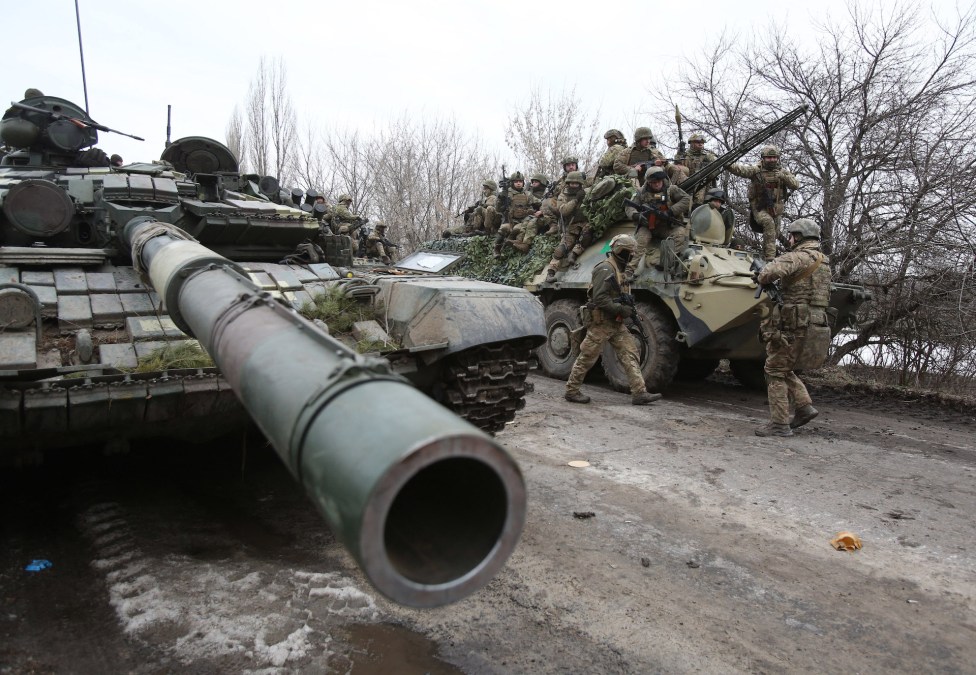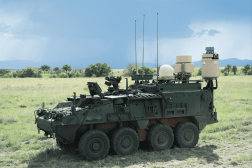Russia’s lack of electronic warfare in Ukraine puzzling to experts

Despite being considered a world leader in advanced electronic warfare capability and tactics, Russia so far has not demonstrated its perceived prowess during the nearly two-week invasion of neighboring Ukraine, according to several experts.
In previous instances and operations in Ukraine dating back to 2014, Russia has demonstrated the ability to target cell phone networks and send messages to Ukrainian soldiers and target forces based upon their electromagnetic signature. These sophisticated tactics have forced the U.S. military, particularly the Army, to alter some of its tactics and capabilities in order to stay ahead of the Russian threat, to include reducing the electronic signatures of command posts as to not be targeted by Russian forces.
But Russia has not brought to bear its full might in the electromagnetic spectrum yet.
“We have not seen what we believe [are] the full scope of their electronic warfare capabilities brought to bear. Cannot give you an assessment of why that would be. But we do know and we do have indications that in some places they have used EW to their advantage, particular in jamming, at a local level,” a senior defense official told reporters in early March, according to Breaking Defense.
Experts have been puzzled by the lack of electronic or electromagnetic spectrum warfare in the conflict so far.
“The seeming lack of EW front line systems is puzzling to those of us who tracked Russian EW” tactics and concepts, Samuel Bendett, an adjunct senior fellow at the Center for a New American Security, said, noting that prior to the invasion, Russia had postured electronic warfare equipment at the border.
Experts offered several possible reasons why Russia’s electronic warfare capabilities either haven’t been used much or haven’t been used to great effect in the conflict so far.
One could be simply poor logistics and planning.
“One of the reasons that we’re seeing them not being used is just a complete and utter failure of logistical and command and control support of Russian forces in aggregate across the board,” said Aaron Brantly, director for the Tech4Humanity Lab at Virginia Tech, adding there have been reports of Ukrainians capturing Russian communications equipment.
Throughout the invasion, there have been widespread reports and military assessments that the Russians’ logistical lines have failed.
“They’re having a lot of coordination problems. I think that’s part of what you’re seeing is that the Russians’ coordination of the invasion has been flawed, which is part of why they get bogged down,” said Bryan Clark, senior fellow and director of the Center for Defense Concepts and Technology at the Hudson Institute.
Others posited it could be poor equipment or the equipment was not fit for purpose.
Brantly noted that the Russians might also be suffering from poor equipment and management. He explained that the Russians experienced poor battlefield communication during operations in 2008, which was supposed to be alleviated with a reorganization and military leadership changes.
However, it appears some modernized military equipment may not have made it to the field, he said, emphasizing this assessment was speculation.
Another possible explanation is poor tactics — specifically, Russians not wanting to use jammers for fear of disrupting their own battlefield communications.
Russian troops have been observed using commercial communication such as cell phones and stealing SIM cards. This likely indicates a problem with battalion-level and below communications, Brantly said, indicating the Russians are probably reliant on the local Ukrainian communication infrastructure, signaling they don’t have their own resilient or redundant communications.
While jamming can be quite effective at blocking enemy communications, if the jamming technique is too blunt, it can also interfere with friendly communications, a lesson U.S. forces learned during the Afghanistan war in trying to block signals for improvised explosive devices. Sophisticated equipment and tactics, rather, seek to act as a scalpel instead of a blunt instrument to target the exact signals of interest and jam them while not affecting their ability to talk at the same time.
During so-called gray zone operations in Ukraine in the 2014 timeframe, the Russians could get away with using lower-end tactics because the Ukrainians didn’t necessarily want to escalate. Now, in full-scale combat, the Russians have to worry about deconflicting within the spectrum.
“The Russians, for their part, now have to worry about deconfliction. They can’t just start jamming and exploiting signals as aggressively as they were because now they got to use the spectrum a lot more to manage their own operation,” Clark said. “I think they’re saying we’re going to prioritize, maintain our comms open, which means we’re going to probably reduce the amount of jamming that we tried to employ because they don’t have good electromagnetic management.”
The Russians also might have a lack of targets, which could be another explanation for the lack of electronic warfare use.
“In order to leverage a lot of the more tactical battlefield types of EW equipment, they have to have very specific targets to go after,” Brantly said, adding, “When you start mixing and matching equipment between Ukrainian and Russian and civilian and military, being able to target specific forms of equipment becomes increasingly difficult.”
If the Ukrainian Army is also fighting more like a militia and isn’t as reliant on the spectrum, that would deny the Russians adequate targets as well, Clark said.
Similarly, others have expressed that the Ukrainians have increased their capability, which appears to have befuddled the Russians.
The Ukrainians were provided radios by western partners, which have more advanced waveforms making them harder to jam if adversaries aren’t used to them.
Moreover, given the conflict has broken out from the gray zone, the Ukrainians likely brought out their best military equipment and tactics.
They’re also not solely relying on cell phone networks that were demonstrated as being easy to hack or spoof. Additionally, others have observed that training from western partners has provided the Ukrainians better tactics such as understanding when to turn on radios and when not to. Once a radio or an electronic system is turned on, it can be observed in the electromagnetic spectrum, geolocated and targeted.
U.S. observations
Experts explained there is much the U.S. military can take away from observing how Russia is employing electronic warfare capabilities and tactics in Ukraine.
The Army’s organization in charge of setting requirements for new electronic warfare systems, the Cyber Center of Excellence, referred comments regarding what it would want to learn to the Pentagon. The Pentagon did not respond to a request for comment.
For its part, the Air Force only offered “maintaining electronic warfare capabilities to enable dominance within the electromagnetic spectrum continues to be our focus in providing air and space superiority for our joint force.”
Based upon what’s been observed so far, while positive for the U.S., Brantly and others suggested not getting complacent.
“Hopefully, the U.S. military doesn’t come away saying, ‘Oh, we don’t have a threat,’ but rather they come away saying, ‘We are training better and we should continue to train better than our adversaries,’” he said.
For Clark, one of the big takeaways should be the importance of electromagnetic spectrum battle management, something the military has begun to pay much closer attention to.
He also pointed to the fact that modernized radios appear to be pretty effective, maybe more so than previously thought.
What to expect next in Ukraine
While Russia’s use of electronic warfare to date has been minimal or underwhelming, that doesn’t mean that will continue.
As the conflict shifts and Russia continues to be stymied, it may turn to different, more brutal tactics in which it will need to rely more on electronic interference.
“They’re just going to get brutal, and at the point where they’re willing to start shelling whole cities, maybe you would see electronic communications interference, EW type activity,” Klon Kitchen, senior fellow at the American Enterprise Institute, said. “You’ll definitely see, we’ll call it tactical cyber, where they’re trying to influence or interrupt Ukrainian decision making, internal comms, internal knowledge transfer, but I think to the degree that exists will be pretty low level.”
Similarly, for Brantly, he is worried that as the conflict transitions to a potential insurgency, electronic warfare could be used to target insurgencies or individuals within the population.
Clark also believes that Russia will ramp up its jamming as the conflict progresses, possibly because as Ukrainian forces collapse into urban centers or bases, coordination of jamming and friendly forces will become easier.
“They may be able to afford some jamming of their own communications because everybody is closer,” he said. “As you drive into the country, your logistics catch up with you, you’re all closer together, the operations may be going more slowly. All those things make it easier to coordinate. Maybe they can then afford to reduce their own comms and allow more jamming to occur.”
He also said he expects to see more use of drones to sense, detect and even jam enemy forces, something the Russians have done previously but that has not been very prominent thus far during operations.






